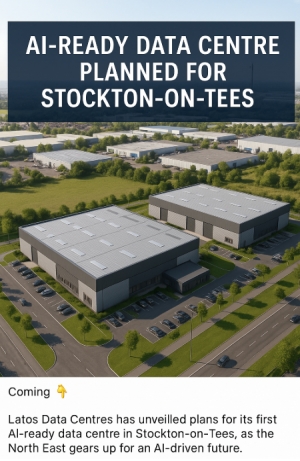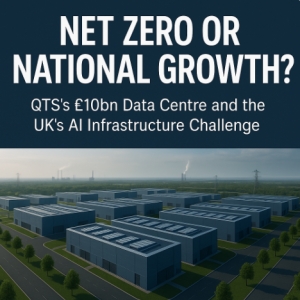The North East is Powering Up: Two Major Data Centre Projects Signal a Digital Revolution
The North East is rapidly emerging as one of the UK’s most strategically important tech regions. With Latos Data Centres unveiling plans for a new high-tech data centre in Stockton-on-Tees, and Blackstone’s £10 billion hyperscale development already underway in Northumberland, the area is on the cusp of a major AI-led transformation.
Stockton’s AI-Ready Data Hub
Latos has submitted proposals to build its first facility at Preston Farm Industrial Estate. This new site would feature two data halls and office space, offering infrastructure specifically designed to meet rising demand from AI and advanced digital workloads.
The project is expected to generate around 150 local jobs during its construction and operational phases, boosting the Teesside economy and positioning Stockton as a hub for next-generation digital infrastructure.
Meanwhile, in Northumberland
Just up the road in Cambois (near Blyth), Blackstone-backed QTS is progressing with one of the largest data centre campuses in Europe.
Key facts:
- Estimated cost: £10 billion
- Ten large-scale data halls
- Around 1,200 construction jobs and 400 permanent roles
- £110 million pledged to local infrastructure, training, and community investment
This project has full backing from Northumberland County Council and major pension fund investment, including the UK’s USS (Universities Superannuation Scheme).
A Growing Demand for Talent
These projects are separate, but they overlap in one major area: workforce.
Together, they will create sustained demand for:
- Data cabling and structured cabling engineers
- Electrical and mechanical contractors
- IT infrastructure and support technicians
- Project managers and technical operations specialists
There is a genuine risk of labour shortages if recruitment, training, and talent pipelines don’t keep up. This will impact contractors, recruiters, and the wider supply chain across the North East. For companies already operating in the data centre space, competition for qualified personnel could become intense.
Conclusion: Infrastructure is Only Half the Challenge
The developments in Stockton and Northumberland represent a massive vote of confidence in the region’s digital future. But infrastructure alone isn’t enough. Delivering these projects successfully will depend on having the people in place — and that means upskilling, training, and mobilising the North East’s tech workforce at pace.
The next few years could define the region’s place in the UK’s AI and digital landscape. These two projects are just the beginning.
A major data centre project backed by Amazon is taking shape near Houghton Regis in Bedfordshire. It is already one of the most talked-about infrastructure developments in the UK.
Jobs and Investment on a Massive Scale
Known as Linmere Island, the complex will sit on a 22-acre greenfield site and is set to become a key part of the UK’s digital backbone. Amazon Web Services (AWS) plans to invest £8 billion in UK data centres, a move the Government has hailed as a signal that "Britain is open for business."
The project is expected to create hundreds of construction jobs and support long-term technical and operations roles once the site is active. In the surrounding region, this could deliver a real boost to the local economy, from logistics and facilities to skilled IT and infrastructure work.
The Power Challenge and the Opportunity
Data centres require significant power to operate. This site alone is projected to use 114.8 million kWh annually, equivalent to powering more than 42,000 homes. However, this also presents a unique opportunity to position the UK as a leader in green, low-carbon data infrastructure.
Here are a few possibilities:
Green Energy Commitments
Although early plans include just 140 solar panels, there is scope to go further:
- On-site solar or wind generation could help offset demand
- Battery storage solutions could reduce strain on the grid
- Partnerships with UK renewable suppliers may ensure a more sustainable energy mix
Smarter Cooling Solutions
Water usage is another important consideration, but several efficient alternatives exist:
- Closed-loop cooling systems can minimise water waste
- Heat recovery systems could supply local homes or buildings
- Smart HVAC controls allow energy-efficient, on-demand cooling
Cleaner Backup Options
The current plan includes 42 diesel generators to ensure resilience. Long term, there are cleaner alternatives:
- Hydrogen fuel cells
- Biofuel-powered generators
- Grid-tied battery systems
A Model for Sustainable AI Infrastructure
Data centres have been designated critical national infrastructure. They are vital to AI development, healthcare systems, financial platforms and cloud computing. The challenge is how to support digital growth while maintaining net zero commitments.
With thoughtful planning and green innovation, Linmere Island could become a flagship for sustainable digital infrastructure in the UK and beyond.
In Summary
The energy demands are significant, and environmental concerns are valid. But this project also creates an opportunity to lead by example, generating skilled jobs, driving economic recovery and embracing smart green technologies.
We should not just build more data centres.
We should build better, cleaner, future-ready infrastructure for the UK.
Big news for South Manchester. Planning permission has now been granted for a brand-new £32 million Culture Hub in Wythenshawe town centre. This marks the first phase of a wider £500 million redevelopment of the Civic district.
This isn’t just a facelift. It’s a complete reimagining of what the town centre can become.
What’s Coming
The new Culture Hub will rise on the site of the former Co-op store and feature:
Ground floor: Vibrant food and drink outlets to encourage footfall and social connection
First floor: Flexible spaces for creative studios, workshops, exhibitions, and community events
Second floor: A 200-seat theatre complete with rehearsal space, designed to showcase local talent and host live performances
Who’s Delivering It
Construction is scheduled to begin in autumn 2025, with opening expected in spring 2027. The development is a collaboration between Manchester City Council and a private development partner, with a major UK contractor expected to deliver the build.
Funding the Vision
£20 million of funding is coming from central government through Levelling Up initiatives. Manchester City Council is contributing a further £11.9 million. This £32 million investment is part of a much larger £500 million regeneration plan for Civic.
Why It Matters
The Culture Hub is more than just a building. It represents a commitment to transforming the local high street and supporting the long-term future of Wythenshawe. It will act as a cultural anchor for the area, supporting:
Up to 2,000 new homes
A new public park
Modern workspaces and retail units
Improved infrastructure and access to public transport
This development puts community, creativity, and connection at the heart of regeneration.
In Summary
Project Name: Wythenshawe Culture Hub
Total Budget: £32 million (first phase)
Construction Start: Autumn 2025
Expected Opening: Spring 2027
Main Features: Food outlets, studios, theatre
Wider Development: Part of a £500 million Civic regeneration plan
Net Zero or National Growth?
Net Zero vs. National Growth: What QTS’s £10bn Data Centre Tells Us About the UK’s AI Infrastructure Challenge
In the race to become a global leader in AI and digital infrastructure, the UK government faces a clear trade-off: scale up fast or stay green. The new £10bn “hyperscale” data centre project near Blyth, Northumberland, led by QTS and backed by Blackstone, is the latest lightning rod in this national balancing act.
What’s Happening in Blyth?
QTS plans to build 10 large-scale data centres across a 133-acre site, with construction starting later this year. Once operational, the site is expected to emit more CO₂ annually than Birmingham Airport — roughly 184,000 tonnes. For context, that’s about 12% of Northumberland’s entire industrial emissions target by 2030.
Powering AI, But at What Cost?
Data centres, especially those underpinning AI workloads, consume vast energy. Estimates suggest global AI-related centres may demand 23GW of power by the end of 2025. The UK’s total current demand is around 30GW.
This strain on the grid explains why nuclear is back on the table. Microsoft and Google are investing in nuclear solutions to support AI expansion, but even they’ve admitted to rising emissions in recent reports.
The Net Zero Dilemma
Keir Starmer’s administration, like many before it, champions tech investment to fuel growth. But can the UK meet its 2050 net zero commitments if each new site rivals an airport in emissions?
Despite calls for more renewables or battery storage, QTS has deemed such options "impractical" for now. They’ve promised energy-efficient design and water-cooled infrastructure, but questions remain.
What This Means for Our Industry
For those of us involved in structured cabling, infrastructure recruitment, and mission-critical builds, this development underlines two truths:
- Data centre growth is not slowing. If anything, AI demand is accelerating hyperscale builds faster than regulations can adapt.
- Sustainability will be a growing pressure point. Clients, councils, and communities will increasingly scrutinise emissions and energy usage on projects.
Final Thoughts
This isn’t just a planning story — it’s a signal. Whether you’re recruiting cleared engineers, designing DC fitouts, or advising on fibre deployment, the sustainability conversation is becoming central. Expect councils to ask tougher questions and clients to lean more on suppliers who understand both the technology and the environmental nuance.
The UK wants to be an AI powerhouse. But the cables, cooling and kilowatts behind that vision must walk a tightrope between growth and green.






